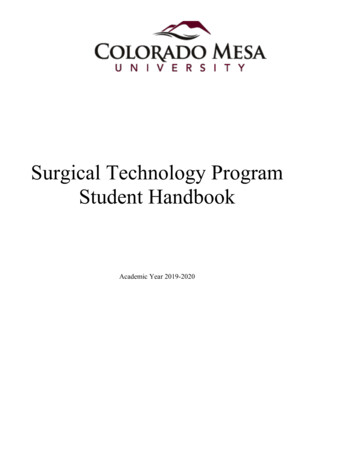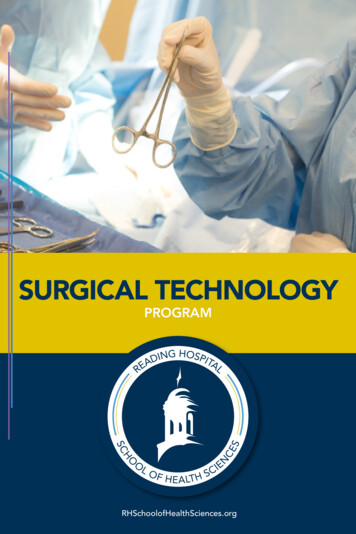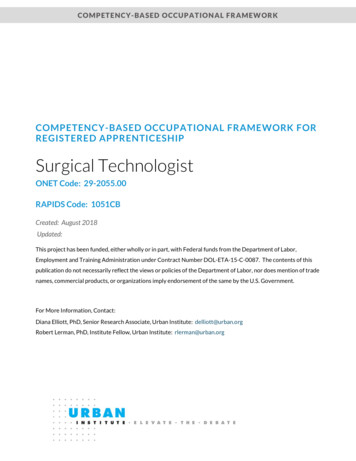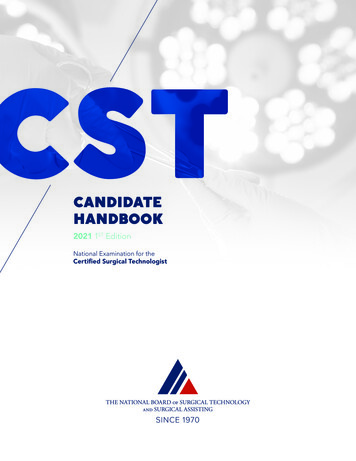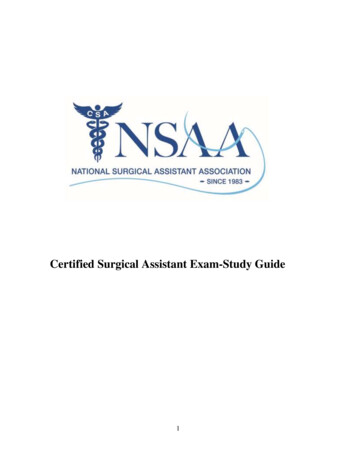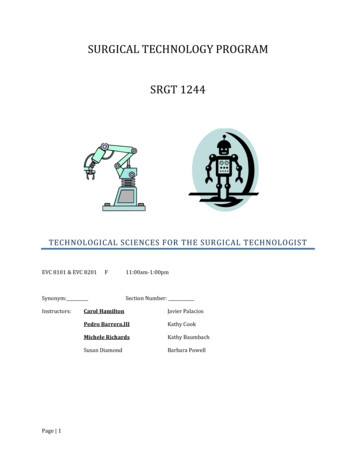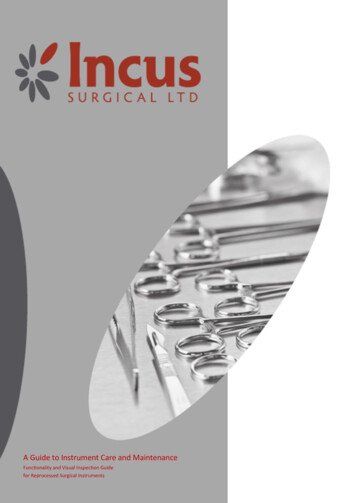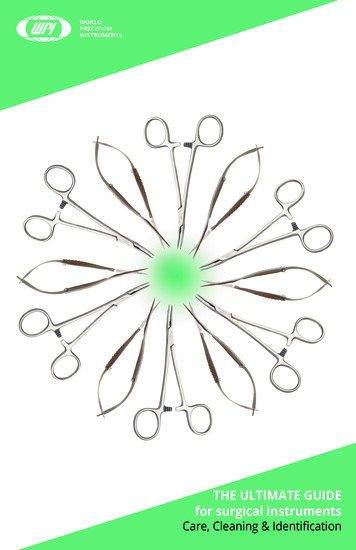
Transcription
THE ULTIMATE GUIDEfor surgical instrumentsCare, Cleaning & Identification
CONTENTSBRIEF HISTORY OF SURGICAL INSTRUMENTS 2WHAT IS STAINLESS STEEL? 4Mechanical Property of Stainless Steel Grades 5WHICH ALLOY IS BEST FOR MY INSTRUMENTS? 6PERFORMANCE 7HOW ARE SURGICAL INSTRUMENTS MADE? 8ForgingHeat TreatingFlashingFinishing8888BE THE INSTRUMENT EXPERT 9Scissors 9Tweezers 10Hemostats 10Needle Holders 11Retractors 12HOW DO I SELECT APPROPRIATE INSTRUMENTS FOR MY APPLICATION? 13Cutting Instruments 14Grasping Instruments 16Retractors 20CLEANING YOUR INSTRUMENTS 20Rinsing 20Manual Cleaning 20Ultrasonic Cleaning 22Automatic Washer 22Soaking 23STERILIZING YOUR INSTRUMENTS 23Autoclaving 23Cold Sterilization 23INSPECTING YOUR INSTRUMENTS 24Scissors 24Needle Holders 24Retractors 25Cutting Forceps/Rongeurs 25Pin & Wire Cutters 25Tweezers 25STORING YOUR INSTRUMENTS 25STAIN GUIDE FOR STAINLESS STEEL 26GLOSSARY 27BIBLIOGRAPHY 29Copyright 2021 by World Precision Instruments, Inc. All rights reserved. No part of this publicationmay be reproduced or translated into any language, in any form, without prior written permission ofWorld Precision Instruments, Inc.World Precision Instruments1
BRIEF HISTORY OF SURGICAL INSTRUMENTSSurgical instruments go as far back as 10,000 BC. Archaeological discoveries haveunveiled cutting tools like a sharp flint used to sharpen animal teeth, grasping toolsto extract arrows, saws, forceps and other ancient surgical instruments. Rubbleamidst the volcanic ashes of the old Roman city of Pompeii unveiled an entirewell-preserved arsenal of surgical instruments. The find is known as the House ofthe Surgeon, because of the nature of the collection found in the home.Claude Moore Health Sciences Library by the University of Virginia received areproduction of the Pompeii instruments in 1947. This library is one of the bestpreserved collections of this nature. Few changes have been made to surgicalinstruments’ design and functionality since Hippocrates (5th century BC), who iscalled the father of medicine, and Galen (2nd century). Here are a few examplesalong with short description of how the instruments were used. The descriptionsof the usage were provided by the medical writers of antiquity.Hooks (Greek name: agkistron, Latin name: hamus, acutus) like the ones on the nextpage served the same purpose as today, to dissect blood vessels, manipulation orretracting. Both blunt and sharp were found.2World Precision Instruments
Image courtesy of Historical Collections & Services, Claude Moore Health Sciences Library, Universityof Virginia.Scissors (Greek: psalis, Latin: forfex) were used in ancient Rome for cutting hair,which was considered a medical procedure. Regular scissors where used. There arefew references for surgical use of scissors, except for a few references to tissue cutting.Image courtesy of Historical Collections & Services, Claude Moore Health Sciences Library, Universityof Virginia.Forceps (Greek: tricholabis, Latin: vulsella) may not have been surgical instruments.There is little indication that the forceps were used for medical purpose, but ratherarticles mentioned them in cosmetic usage such hair removal and art.Image courtesy of Historical Collections & Services, Claude Moore Health Sciences Library, Universityof Virginia.World Precision Instruments3
WHAT IS STAINLESS STEEL?Two main criteria to be considered when choosing the instruments are the qualityof the steel and the manufacturing process itself. Manufacturing quality instrumentsinvolves standards for various aspects of the manufacturing process, including thebasic requirements for quality steel, as well as vigorous inspection for every stepon the process.Stainless steel (Inox in Europe) is a mixture of metals, all playing different roles inthe final alloy. Common elements found in steel composition includes: Pure Iron (Fe) is highly corrosive and soft, but when combined with othermetals, it becomes by far one of the most commonly used industrial materials. Carbon added to the iron gives it hardness, adds consistency when the metalis welded and provides ductility. Ductility defines how a solid material stretchesunder tensile stress. Chromium adds resistance to corrosion, and in combination with the oxygenin the air, creates a more adherent surface film that resist further oxidation. Nickel, magnesium, silicon, molybedum and sulfur are called residualelements and are retained from the raw material. Unless the chemicalcomposition of steel calls for a minimum or maximum of this elements, theymay be present in the composition.The degree to which the steel become “stainless” is determined by all these metals,by the heat treatment applied and by the final rinsing process. The additivesincrease the metal’s capacity to resist highly corrosive environments such as blood,body fluids, salt solutions, cleaning solutions and sterilization methods.Based on the mechanical properties and composition, the American Iron and SteelInstitute (AISI) differentiate all steel, about 80 types, by using 3-digits numbers. Themost used types of steel, when making surgical instruments, are the 300 and 400series described below . This types of steel is rust and corrosion resistant, has goodtensile strength and will provide a sharp edge for repetitive use. The 300 seriessteels are manufactured from the austenic steel class and cannot be hardened byheat treatment. 400 series steels are manufactured from the martensenic steelclass series and can be hardened by heat treatment. Stainless Steel 304 is the most popular variety of steel and is composed of 18%chromium and 8% nickel. This type cannot be hardened by heat treatments.Sometimes this steel is referred to as 18-8. Stainless Steel 316 is the second most popular steel. For this type, theamount of chromium decreases to 16%, the nickel content goes up to 10%and molybedum is added in a concentration of 2%.This combination gives thesteel an increased resistance to salt water corrosion. Stainless Steel 410 is an alloy with a chromium composition of 11.5%. Becauseit has less chromium, it has better corrosion resistance. Stainless steel 409 has the lowest concentration of chromium, 10.5%.Thecorrosion resistance is similar to Stainless Steel 410.4World Precision Instruments
Mechanical Property of Stainless Steel le Strength Yield Strength(1000 psi)2(0.2% 1000 psi)3Elongation(% in 80-827570-756534-453525-3525Rb is the abbreviation for Rockwell hardness measured in the B scale. The test is done by pressinga small indenter against a surface with a specific force.2Tensile strength is the resistance of a material to a force tending to tear it apart. The unit ofmeasure is PSI (pounds per square inch).3The yield strength is the permanent deformation of a material when stress is applied.4Elongation is a measure of the ductility of the steel, how far a material tested for tensile strengthwill elongate before a crack occurs.1Benefits of Stainless Steel Corrosion resistance (alkaline solution, chlorine, acids and water environments)High temperature resistanceEasy to clean, making the best option in hospitals, clinics and laboratoriesCost-effective100% recyclableGrades of InstrumentsSurgical instruments come in three grades: Premium ore quality Intermediate ore quality Floor gradeBoth premium and intermediate grade instruments are made out of corrosionresistant 300 and 400 steel and can withstand repetitive cutting or use, andrepeated sterilization processes. They are manufactured to strict specificationsand subjected to high quality control inspection at several points during themanufacturing process.Floor grade instruments may look the same as the higher grades, but thespecification for steel quality and manufacturing are less strict. Floor gradeinstruments are forged with recycled steel, and the finished product is plated tocover imperfections. These instruments can break more easily, and because theyare plated, they can bend, and they rust relatively easily. This grade of instrumentsis designed for single use or as disposable instruments.In order to avoid tissue damage, impaired healing or infection, good qualityinstrumentation should be used.World Precision Instruments5
WHICH ALLOY IS BEST FOR MY INSTRUMENTS?Inox, Titanium, Dumoxel , Dumastar , Antimagnetic. Have you ever looked at thevariety of metal alloys for surgical instruments and laboratory tools and wonderedwhich is best for your needs? Here’s a brief rundown.Hardness(Rockwell)Max. Temp.ResistanceCorrosion ResistanceMagnetic55-56350 CGoodYesDumoxel36350 CExcellentNoDumostar62550 C100% Non-corrosiveNoTitanium37550 C100% Non-corrosiveNoStainless Steel & InoxStainless Steel or InoxOur standard line of instruments are manufactured of highest quality materials,they are made of austenitic 316 steel commonly known as “surgical steel” or “marinegrade steel.” The steel is highly corrosion-resistant, and it is a common choice ofmaterial for biomedical implants or body piercing jewelery. It is in compliance withASTM F138. This WPI line is an excellent alternative to German surgical instruments.The high-quality, corrosion-resistant instruments are available at a fraction of theprice of German surgical instruments.Inox (stainless steel) is well suited for medical purposes, because this stainlesssteel, magnetic alloy has excellent corrosion resistance and good salt resistance.Temperature resistant up to 400 C, it can be autoclaved at 180 C. Almost as strongas carbon steel, Inox is an excellent general-purpose alloy for surgical instruments.Titanium100% anti-magnetic, corrosion-resistant, lightweight and strong, titanium alloy isideal for biological and medical applications. Titanium has the tensile strength ofcarbon steel and is completely resistant to corrosion from nitric acid, chloride,saltwater, industrial chemicals and organic chemicals. Titanium is more flexible and40% lighter than Inox. When heated or cooled, the dimensions of titanium alloychange less than half of what stainless steel alloys will, making titanium surgicalinstruments much more durable. Titanium is stain-free and temperature resistantup to 430 C. Titanium is the softest alloy for surgical instruments. Titanium toolsare the premium choice for corrosive environments or MRI applications.Dumoxel Developed by Dumont Tools, Dumoxel is highly resistant to sulphuric environments,hydrochloric acid, mineral and organic acids. Extremely flexible, Dumoxel is95% antimagnetic and stain resistant. The high molybedum and chromiumcontent increases its resistance to corrosion. It is more likely to bend than break.Temperature resistant up to 400 C, it can be autoclaved at 270 C. Dumoxel is themost popular Dumont alloy for tools.Dumostar Patented by Dumont Tools, Dumostar is more elastic and more corrosion-resistantthan the best stainless steel. It is resistant to minerals, organic acids and saltcorrosion. Dumostar is 100% anti-magnetic and temperature resistant up to 500 C.It is highly resistant to metal fatigue, has great elasticity and is durable. It is more6World Precision Instruments
likely to bend than break. Dumostar is the most cost-effective and appropriatealloy for laboratory tools.AntimagneticWith good corrosion resistance, this alloy is 80% antimagnetic. Temperatureresistant up to 400 C, it can be autoclaved at 270 C. Antimagnetic is not quite ashard as Inox.Tungsten CarbideAs a general rule, surgical instruments with tungsten carbide inserts performing thesame type of work will last up to five times longer than stainless steel instruments.The additional length of service makes tungsten carbide surgical instruments morecost-effective than cheaper models.Black Titanium CoatedOur black instruments are coated with titanium nitride(TiN), an extremely hard ceramic material. The TiN coatinghardens and protects the cutting edge. Ceramic coated anti-reflective instruments areperfect for microscopy and microsurgical applications. Coating surgical instrumentswith a black ceramic adds a thin layer to the metal instrument, making the instrumentharder and giving you greater precision. This anti-glare surface minimizes reflectionsoff the surface of your instruments. The incredibly smooth coating improves theinstruments’ resistance to corrosion and minimizes friction. The ceramic coating is virtuallyimpenetrable, because the raw material is bonded to the instrument both physically andchemically. These instruments are much more resilient to the pressure of daily use andchemical processing. Coated instruments last considerably longer.PERFORMANCESurgical instruments are designed to perform diagnostic, therapeutic, orinvestigative operations having specific functions such as to cut or incise, retract,grasp, hold or occlude, dilate or probe, suture or ligate.The majority of surgical instruments are made of stainless steel or titanium (usedwhere non-magnetic instruments are required). Stainless steel is an alloy thatcontains a minimum 12% chromium for corrosion resistance.The instruments can vary in quality and price and often represent a large portionof a surgical budget. Caring for this investment is the responsibility of all who usethem from technicians to surgeons.Managing the instrument care process begins with understanding the many typesand styles and using the correct one for your procedure. Most surgical instrumentsare made of surgical stainless steel and are quite robust and resilient, however,they are not indestructible. Stainless steel does stain. It just stains less than othertypes of steel.Properly cleaning and caring for your surgical instruments is the single easiestway to prolong their use and improve the outcome of your surgical procedures.Choosing the correct surgical instruments is imperative for assuring your success.This guide will help you to understand the importance of choosing the right materialfor your instruments and what it takes to get the instrument from raw materialto finished product, as well the importance of routine cleaning and maintenance.World Precision Instruments7
HOW ARE SURGICAL INSTRUMENTS MADE?Surgical instruments can be madeof a variety of materials. Series 300surgical stainless steel is the mostcommon. In metallurgy, stainless steelrefers to a steel alloy, meaning rawsteel is combined with other metals toimprove various properties. A very smallamount of carbon is added to increasethe strength of the steel, and at least11% chromium is added to increasethe corrosion-resistance. The processby which surgical instruments are created includes forging, grinding, milling,finishing and heat treating.ForgingForging involves stamping an outline of the instrument on the steel. It is the basisfor a quality instrument. Heated stainless steel is stamped using a die.Heat TreatingThe heating and cooling process must be done very carefully to result in a highquality forging and high quality surgical instruments.FlashingThe edges of the forging, called flashing, arevery rough and are removed by grindingand milling during the second phase ofproduction.FinishingAfter the rough edges are removed fromthe open spaces such as in the ring handles,machinery is used to finish the instrument. Finishing includes honing the bladesto the appropriate sharpness, creating the male and female halves of scissors,hemostats and other hinged instruments, creating serrations, etc.Once the instruments are sharpened and assembled, they are heated and then cooledin a controlled process called annealing. Annealing the instruments conditions themetal to be strong and hard. Once cooled the instruments then go through polishingand passivation. Polishing ensures a smooth finish for the instrument and can resultin either a shiny, mirror finish or a satin/matte finish. Both finishes are acceptableand have their own virtues. A mirror finish reflects light, which can be annoying undersurgical lights, however, it discourages staining. A satin finish does not reflect light,however, it is more susceptible to staining.Passivation, the formation of a hard, non-reactive surface film that inhibits furthercorrosion, is achieved by submerging the instrument in nitric acid. The nitric acidremoves the iron remnants from the outer layer of the instrument and increasesthe formation of a protective chromium layer.Marking instruments, often with the instrument company’s name or brand, isgenerally done by acid etching which does not affect the integrity of the instrument.8World Precision Instruments
BE THE INSTRUMENT EXPERTScissorsScissors are widely used in healthcare units, hospitals and laboratories. The smallersized blades are used at the surface for small incisions and the longer blades godeeper into cavities. Curved blades provide a better visual of the working area andstraight blades can be used for any type of incision.Ring HandlesBlade LengthCutting Edge LengthHingeShankOverall LengthStandard Scissor TipsStandard scissors are available in a variety of lengths and patterns with straight,curved or angled blades. Heavy duty patterns are for blunt dissection. Fine, thinblades are used for delicate cutting.Curved blade, side viewBlunt/blunt bladesSharp/sharp bladesSharp/blunt bladesMicro Scissor TipsMicro scissors are often called Vannas or spring scissors. They are excellent forleft hand users.Straight bladesCurved bladesAngled bladesWorld Precision Instruments9
TweezersTweezers are used for grasping tissue, cells and other materials, generally under amicroscope. The tips are sharpened to a fine point. Tweezer tips are measured byexamining a cross section of the tip and measuring the width and the depth. Thewidth is the first number reported, and the depth is the second number.depth0.1 x 0.06 mm tipswidthTweezer TipsStraightCurved45º Angled90º AngledHemostatsRing forceps (also called hemostatic forceps) are hinged and look like ring scissors.Frequently, hemostatic forceps have a locking mechanism called a ratchet, whichis used for clamping. The jaws of the locking forceps gradually come together aseach increment of the ratchet is employed.Ring forceps are used for grasping, holding firmly or exerting traction upon objects.For especially delicate operations, generally ring handles with a locking ratchet arepreferred over thumb forceps.Locking hemostatic forceps may be called clamps and are used to securely holdtissue. When they are used to control blood flow, they are called hemostats.Hemostats are typically used to compress blood vessels or other tubular structuresto obstruct the flow of blood or fluids.Ring HandlesJaw LengthBox LockShankRatchetOverall Length10World Precision Instruments
The jaws can be straight, curved or right angle. They come in a variety of sizesdepending on your application. For example, Mosquito hemostats clamp smallblood vessels, and Kelly hemostats can be used to clamp larger vessels orgrasp tissue. Kelly hemostats and Rochester forceps look similar. However, Kellyhemostats have shorter serrations. Rochester hemostats can reach a little deeper.Hemostat TipsCrile hemostats, straightRochester-Pean hemostats, straightKelly hemostats, curvedRochester-Carmalt hemostats, curvedNeedle HoldersNeedle holders, also known as needle forceps or needle drivers, are used insuturing during a surgical procedure. Needle holders typically have a texturedtip for a secure hold. Often they have a ratchet (or other mechanism for locking).Some have tungsten carbide inserts in the tips. Tungsten carbide inserts are moredurable than stainless steel, last longer and typically offer a better grip. Tungstencarbide (TC) is harder than stainless steel. Look for the gold handles which designatetungsten carbide inserts. Titanium needle holders are lighter weight, which makesthem easier to use during long procedures. Choose your needle holders based onthe size of the needle you are using, so that they securely hold your needle. Thesmaller the needle, the smaller the needle holder.Ring HandlesJaw LengthShankBox LockRatchetOverall LengthStandard Needle Holder TipsThe ratchet locks the tips on the needle of standard needle holders. The tipscan be straight or curved. Serrated tips work better for holding larger needles.Smooth tips are designed for the smallest needles. Some needle holders havebuilt-in suture scissors.World Precision Instruments11
Ryder, serrated jawSmooth jawStandard, serrated jawMicro Needle Holder TipsMicro needle holders have the spring (squeeze) handles for ambidextrous use.They come with or without a lock, smooth or serrated, and straight or curved.Serrated jawSmooth jawCurved jawRetractorsRetractors are used to hold an incision or a wound open, to hold an organ ortissue out of the way to expose what’s underneath. Three broad categories ofretractors include: Hand Retractors must be held by an assistant, a robot or the surgeon duringa procedure. Self-Retaining Retractors have a mechanical device for holding tissue duringsurgery, allowing hands free operations. Self-retaining retractors have a screw,ratchet or some type of clamp to hold the tissue. These allow the surgeon tooperate with two free hands. Wire Retractors are the simplest style of retractor. Usually the wire has somespring so that the surgeon can pinch it together, position it and release it.These also free up the surgeon’s hands.The most common retractors include the Belfour, Gelpi, Weitlaner, Barraquer, Wireand Stevenson retractors.ProngsRing HandlesHingeJawRatchetthLengOverall Length12World Precision Instruments
HOW DO I SELECT APPROPRIATE INSTRUMENTSFOR MY APPLICATION?There are literally thousands of different surgical instrument patterns and stylesavailable in the world today for an infinite number of applications. The vast majorityof these instruments have been developed for clinical use in human beings and arenot specifically geared toward use in research on very small animals, embryos andcells. However, with a little thought and investigation, an appropriate instrumentcan be found for nearly every surgical research application.Few instruments on the market are made for one specific application, and ofteninstruments are re-purposed into tools that will work in many situations. Forexample, smooth jawed, curved micro needle holders are excellent for mouselaminectomies, but their original use is for driving suture needles.When you are selecting surgical instruments for a procedure, here are a few keypoints to consider. What procedure are you performing? Published research papers usuallyindicate which instruments other researchers have used for similar procedures.The correct surgical instrument for a particular procedure makes a differenceon the outcome of that technique. What is the size of your subject? An instrument that is perfect for a 200 –300 grat (about 22–25 cm long) may not be the best choice for a neo-natal mouseof about 15 g (about 1–2.5 cm long). How often will the instrument be used? If you perform more than 100 cutsper day, a pair of titanium scissors or a pair of scissors with tungsten carbideinserts would be worth considering. They stay sharp longer.Let’s consider some of these factors and offer a few tips for selecting an appropriatepair of scissors, tweezers and forceps.When selecting instruments, it is helpful to understand the methods used tomeasure and communicate the various attributes of an instrument. Length is fairlyobvious, but there may be some confusion about blade length, tip dimensions,retractor openings, tooth dimensions and more.The overall length of an instrument is measured from the bottom of the handleor rings to the tip.Micro ScissorsCutting edge lengths are measured as the operational length of the cutting edge.For example, a micro scissor blade is measured by looking at the length when thescissor is lying on a surface in the natural open position. This is the maximum thejaws will open without reverse force, therefore, it is the operational blade length.It is most accurate to do the measurement under a microscope using a reticle.CuttingEdgeLengthWorld Precision Instruments13
Standard ScissorsThe cutting edge length on standard scissors requires a little bit more subjectivity,but will still be an adequate measurement. They are measured by opening thescissors to a normal, natural opening and measuring the distance from the tip towhere the two blades cross.CuttingEdgeLengthCutting InstrumentsMost surgical instruments can be used for general surgery in a research laboratorysetting. Instruments may be roughly categorized by function. Cutting instrumentsinclude scissors, surgical blades, knives and scalpels.ScissorsFine tip scissors (like Vannas, Castroviejos and McPhersons) are ideal for use in veryrestricted spaces. They are perfect for right or left hand use, and are designed forophthalmological procedures, which require a delicate incision of tissue. You canmake quick, accurate cuts with minimal tissue damage using these sharp blades.TIP: Curve tipped scissors are a good choice when you want to avoid cuttingunderlying tissues.TIP: Scissors designed with a heavier construction (like Metzenbaum, Mayo andSuperCut scissors) are useful for cutting fur, thicker tissue, bone or muscle.Metzenbaum Scissors with tungsten carbide insertsTIP: The length of the scissor tips should match the depth of the incision you needto make.Black Ceramic ScissorsOur black instruments are coatedwith titanium nitride (TiN), anextremely hard ceramic material.The TiN coating hardens andprotects the cutting edge. Ceramic coated anti-reflective instruments are perfect formicroscopy and microsurgical applications. The ceramic coating is virtually impenetrable,14World Precision Instruments
because the raw material is bonded to the instrument both physically and chemically.These instruments are much more resilient to the pressure of daily use and chemicalprocessing. Coated instruments last considerably longer.Corrosion resistant Non-reflective Low friction Wear & tear resistant BiocompatibleSuperCut ScissorsOur black handled surgical scissors designate ourSuperCut scissors. These scissors have one razor sharpblade and one micro-serrate blade. The sharp edge givesa clean cut with minimal tissue damage, and the serrated edge actually holds thetissue to prevent it from slipping while you are making an incision.Iris SuperCut ScissorsTissue is “crushed”between the two standardscissor blades as theycross. (Look at a regularpair of scissor blades tosee the flat surface.)Tissue is “sliced” by theknife-honed edge ofSuperCut scissors.Side view comparison of standard scissor blades and knife-edge honed SuperCut blades.Tungsten Carbide ScissorsScissors with tungsten carbide inserts have golden handles. Tungsten carbideinstruments are more durable, hold an edge longer and last longer than stainless steelinstruments. Scissors with one black handle and one gold handle are both serratedand have tungsten carbide blade inserts, giving you the very best of both worlds.Spring ScissorsSpring scissors are perfect for left or right hand use. They are designed forneurosurgical, vascular, microsurgical and ophthalmological uses. Vannasscissors are delicate spring scissors. They are used frequently in ophthalmic andneurosurgical applications. The fine scissor blades are sharp. Vannas scissors workwell under a dissection microscope.Sapphire Blade for a KnifeSapphire blades may be used in microsurgery, dissection and related applications.They are not as hard as a diamond, but still hundreds of times harder then a razorblade. Sapphire blades can cut
Surgical instruments go as far back as 10,000 BC. Archaeological discoveries have . unveiled cutting tools like a sharp flint used to sharpen animal teeth, grasping tools . to extract arrows, saws, forceps and other ancient surgical instruments. Rubble amidst the volcanic ashes of the old Roman city of Pompeii unveiled an entire well-preserved .
